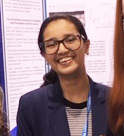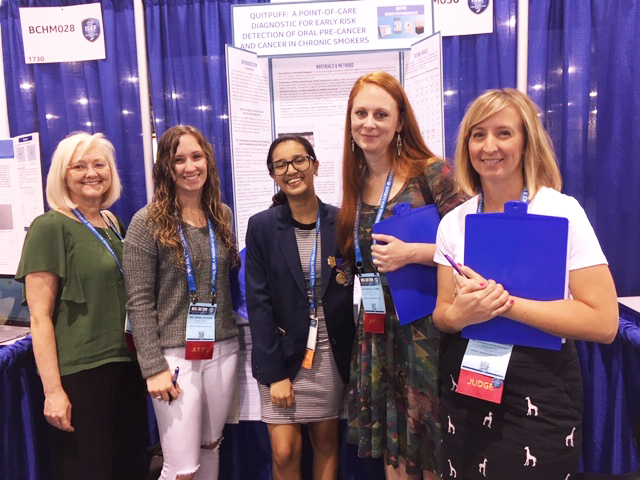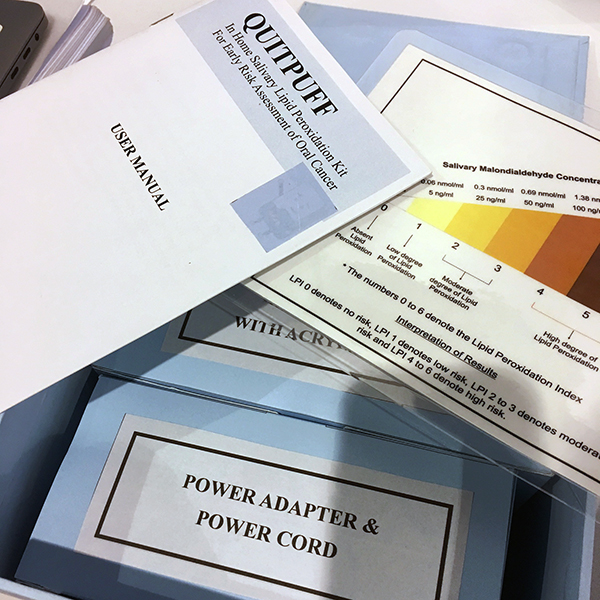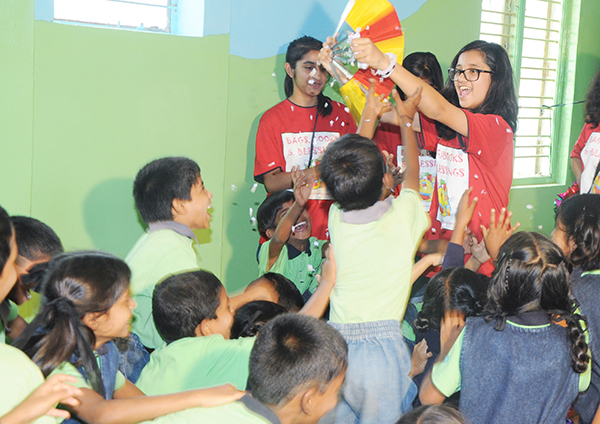 Nikhiya Shamsher
Nikhiya ShamsherProject: QuitPuff: A Point of Care Diagnostic for Early Risk Detection of Oral Pre-Cancer and Cancer in Chronic Smokers
About the Project:
What if you lived in a community where many people smoked, but there was little access to health care? That is the situation faced by a teen in Bangalore, Karnataka, India, where oral cancer accounts for 30% of all cancers in the country. Sixteen-year-old Nikhiya Shamsher of Greenwood High School in Bangalore worried that too many teens and adults in her community were smoking or chewing tobacco but were ignoring signs of mouth cancers because it was too expensive to go to the doctor or a doctor was hard to get to in parts of India.
She decided if she could find an inexpensive chemical test that would identify the amount of MDA in someone’s saliva, that person would be warned that oral cancer was developing (pre-cancer) or had already started to grow. So, she developed a system she named QuitPuff.
 L to R: Judges Drs. Janet Neisewander and Jonna Jackson, Nikhiya Shamsher, Judges Drs. Michelle Jobe and Cassandra Gipson-Reichard
L to R: Judges Drs. Janet Neisewander and Jonna Jackson, Nikhiya Shamsher, Judges Drs. Michelle Jobe and Cassandra Gipson-ReichardQ&A with Nikhiya
- What gave you the idea to create the QuitPuff device?
-
 Image of QuitPuff device presentation at the fair.
Image of QuitPuff device presentation at the fair.On a clowning visit to a hospital I met a 30-year old patient with a distorted face and a missing jaw. Cheered by my clowning, he tried hard to smile, but couldn't and so he cried. A chain smoker, he was diagnosed with oral cancer stage 3 wherein his jaw bone had to be surgically removed. The incident shook me up. I started googling about oral cancer. I read that the survival rate of oral cancer if diagnosed early was 80% and it dropped to 20% if diagnosed late. I read about pathogenesis of cancer, about lipid peroxidation and how it can act as an early marker in oral cancer. Most of what I read went over my head. And it was only after reading them over and over again, that a few things started making some sense. And that’s how I got working on my study and devised QuitPuff.
- How does it work?
-
The test is based on color change produced upon heating saliva with the QuitPuff reagent. The intensity of color produced is directly proportional to the concentration of Malondialdehyde in the saliva sample and is indicative of the degree of lipid peroxidation and the risk of a smoker towards developing oral pre-cancer and cancer.
- What were some of the technical challenges making this device?
-
One of the major challenges while making this device was the heating element. The saliva had to be heated with the reagent for any color change to be produced. In the lab setting, we used a water bath and it took nearly 15 minutes of reaction time. The challenge was to replicate the same in a point-of-care device. However, I realized that the device would need to hold more than 1.5 litres of water. This would make the device bulkier. So, I scrapped the idea of creating a mini-water bath and experimented with dry heat. The challenge was to build a device capable of heating the mixture up to 100 degree Celsius. I used a thermoelectric peltier cooler or generator TEC1-12706 that creates a temperature differential on each side, with an operating voltage of 12V at 6A. This worked well and even reduced the reaction time.
- What does it cost to make?
-
It costed me approx. $20. It was because I used some of my school resources like the 3D printing of the box. However, if we include the cost of 3D printing outside it would be approx. $30.
- What are the challenges in getting acceptance for this kind of product?
-
 QuitPuff device
QuitPuff deviceAs of now, my age is the biggest obstacle. I do not get easy access to officials who have the decision-making power. It is a challenge to find people who understand my passion and can think out of the box. During one of the presentations, I was snubbed by a senior oncologist who told me that these kinds of tests were useless and with his level of expertise, all he needed to diagnose oral cancer was a “torch”. I was disheartened, not because he snubbed me. But because he missed the point of my test completely. I was presenting my test, the aim of which was to detect the risk “early”, much before any visible symptoms or lesions formed that could be detected by a torch.
- Tell us about your home town, your country and your school.
-
I was born in India, one of the most diverse countries in the world, known for its linguistic, geographic and religious variety. For every 300 kilometres you travel, you are hit by a different local language, food, religion and landscape.
My home town is Bangalore. It was once referred to as the Garden city or the Pensioners Paradise. But over the years the city has experienced a dramatic change with the expansion of information technology and business process outsourcing, and now is more aptly known as the Silicon city of India.
My school, Greenwood High, is located on 22 acres of land on the outskirts of Bangalore, amidst a lot of greenery. The large open space, fresh air and serenity fosters a love for learning. Along with an organic atmosphere, it has all the modern amenities like a half-Olympic sized swimming pool, basketball court, library and international standard science labs.
- If you could continue this research, what would you do next?
-
I have presented my project to the officials of the Government of India and have received a research grant under the Gandhian Young Technological Awards 2019. My aim is to improve the specificity and accuracy of the test and make it more specific to suit consumers smoking different categories of cigarette and tobacco like beedi, paan, smokeless tobacco, betel nut, gutka, zarda, mawa, kharra and khaini. I want to explore if a simpler method like a lateral flow assay or a paper strip method could be devised which could make the test more accessible and user friendly. I wish to test my method, take it to clinical trials and eventually launch it as a commercial point-of-care diagnostic test.
- What are your professional goals?
-
On the academic front, I wish to pursue theoretical physics, simply because it reveals many secrets of the universe. And of course, an important component of theoretical physics is math. I believe math is the language by which the universe speaks to itself. If you figure out math and physics, you can figure out the universe, and imagine what we could do with all that information! I had a tough time explaining my subject choices to my school counsellor. I chose Physics, Math and Art. They tried to convince me to drop art and instead take up Chemistry as it would be easier for me to choose a career path. However, I was convinced I wanted to take Art. I love the rationality of Physics and Math, but I also love the abstractness and creativity of Art.
- How does your community feel about women becoming scientists?
-
Fortunately, I have had a very modern upbringing. My parents, my grand-parents, relatives and my immediate community are all broad-minded people. I have never faced gender bias.
My parents are both doctors and equally ambitious, treat each other as equals and neither one is more responsible for housework than the other. Growing up in an environment without gender roles has taught me to be self-reliant, create my own path and is one of the biggest reasons for my foray into the research field.
Largely, my parents and my family have given me the freedom to choose who and what I want to be. If I choose to become a scientist, they would not worry about me being a woman and accept me whole-heartedly with my career choice and decision.
- What do you like to do for fun?
-
 Honorable mention Nikhiya Shamsher performing magic tricks at a Bags, Books and Blessings event.
Honorable mention Nikhiya Shamsher performing magic tricks at a Bags, Books and Blessings event.I have attached a photo of myself performing magic tricks to connect with school kids at one of the events of Bags, Books and Blessings. I have attached one more photo wherein I am explaining a Math concept to students in the Yearn to Learn Math lab.
 Nikhiya at a Yearn to Learn lab with students.
Nikhiya at a Yearn to Learn lab with students.Just to give you a little background, I founded two non-profit activities when I was 12 years old. The first one is called Bags, Books and Blessings which has provided school supplies to 15,325 less privileged students in the last 4 years. The second activity is called Yearn to Learn which has set up 130 fully equipped science and math labs in 30 schools and colleges to promote science, technology, engineering, and mathematics (STEM) education.
